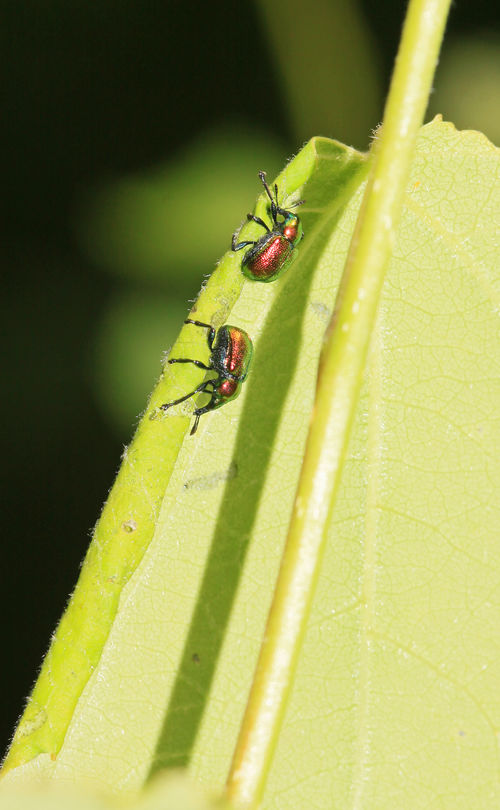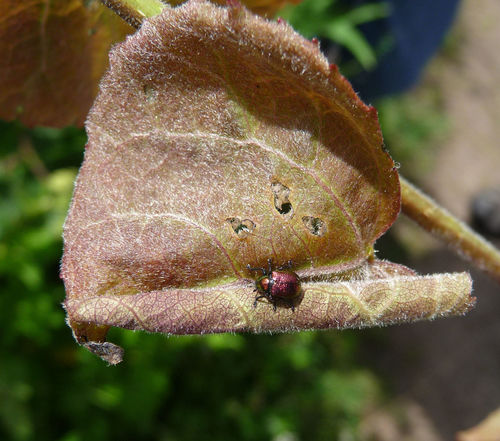Aspen leaf-rolling weevils Byctiscus populi. More sites in north Worcestershire
Brett Westwood
The excellent article in Worcestershire Record November 2011, on the Aspen Leaf-rolling Weevil Byctiscus populi by Steve Lane, prompted me to keep an eye out for this coppery beetle in other than the known sites.
In mid June 2013 I visited Black Meadow in Chaddesley Woods National Nature Reserve (managed by Worcestershire Wildlife Trust), grid reference SO 915737, an old hay meadow bordered on both sides by oak woodland including some mature Aspen Populus tremula. Aspen suckers were invading the meadow in places and on the topmost shoots of these I noticed two or three leaves rolled and hanging downwards in the characteristic manner of the weevil. No weevils were present however, so I returned on 30th June for closer inspection and was pleased to find a few mature beetles and ten leaf-rolls in a stand of 2m tall Aspen suckers. I searched the mature Aspen trees in the adjoining woodland, but could find no trace of adults or leaf-rolls.
On 9th July 2014, I accompanied Woodland Trust volunteers at nearby Pepper Wood grid reference SO 934750 and found a few Aspen leaf rolls and three adult weevils in an overgrown meadow at Gorsy Piece where Aspen suckers were growing. Further searches in the wood produced a few leaf-rolls at a ride junction. It appeared that most of the rides are too shady and although we searched carefully no more were found.
These records suggest that a small population of Byctiscus populi is established in the area. According to Jon Mellings (2002) in an article in Worcestershire Record Fred Fincher recorded the weevil from Randan Wood in 1951, so has it been present here since then or has it re-colonised from locations further south in the county?
Given the importance of Worcestershire for this nationally local and potentially endangered insect, perhaps more effort should be made to retain and encourage suckering Aspen in open areas at Pepper Wood and Chaddesley Woods. It would be a pity to lose such an attractive and symbolic insect.
Photographs of Byctiscus populi in action in the main Worcestershire sites of Trench Wood and Monkwood in previous year are shown on 01 and 02
Note from Tony Simpson, County moth recorder:
Lepidopteran larval feeding which might be confused with Aspen leaf rolling Weevil
Three species of micromoth larvae make leaf rolls on Aspen: by far the commonest is Anacampsis populella (Clerck) which also feeds on other Populus and Salix species in May. More uncommon species rolling Aspen leaves in May and June are Epinotia maculana (Fabricius) and Pseudosciaphila branderiana (Linnaeus). Other moth larvae on Aspen usually spin together leaves one above the other without rolling them. Old vacated leaf rolls remain on the tree after the larvae have finished feeding.
The important point is that nearly always the leaf petioles are not nibbled partly through and so the leaves do not hang down as is the case with weevil leaf rolls.
Editors note
Having been present at the start of Jon Melling’s studies of Byctiscus populi in Monkwood I have since taken an interest in this weevil. Amongst my archive I have a paper by Stretton (1943) in which he describes female weevils leaf rolling and egg laying in great detail. He followed their activity in Sussex in a patch of suckering Aspen and White Poplar Populus alba and all the rolls he saw were made on White Poplar leaves and not aspen. A recent internet search found a paper by Urban (2012) on the biology of the species including detail of leaf rolling and laboratory studies in the Czech Republic. This paper contains a beautiful picture of the weevil labelled ‘female’ but it clearly shows the spine on the side of the thorax which is a male attribute also mentioned by Stretton (1943). The latter never saw a copulating pair. As one might expect nowadays there is a video of this on Youtube and if you are quick-eyed you can see the spine on the male! Leaf rolls made by this species have also been recorded on other species of Populus usually on suckers less than 2 m tall so this is worth looking out for. Urban (2012) describes very clearly how the leaf petiole is always bitten (as described by Tony Simpson above) to cause the leaf to wilt and become suitable for the weevils to roll.
References
Lane, S. 2011. The Aspen Leaf-rolling Weevil Byctiscus populi: An Update on its status, with particular reference to the Worcestershire Population. Worcestershire Record 31:22-25.
Mellings, J. 2002. Byctiscus populi; the status and biology of a rare species Action Plan (SAP) Weevil in Worcestershire. Worcestershire Record 13:25-27.
Stretton, G.B. 1943. Some observations on the leaf-rolling habits of Byctiscus populi L. (Col.. Curculionidae). Entomologists’ Monthly Magazine 79:252-255
Urban, J. 2012. Biology of Byctiscus populi (L.) (Coleoptera, Attelabidae).Part I. Last year’s imagoes. Acta Universitatis Agriculturae et Silviculturae Mendelianae Brunensis. 60:145-153.
Video of mating Byctiscus populi https://www.youtube.com/watch?v=e7ulQj5E7LA
Images
01. Byctiscus populi rolling an aspen leaf Trench Wood 25 May 2011. Wendy Carter.
02. Byctiscus populi rolling aspen leaf Monkwood 27 June 2011. G H Green

